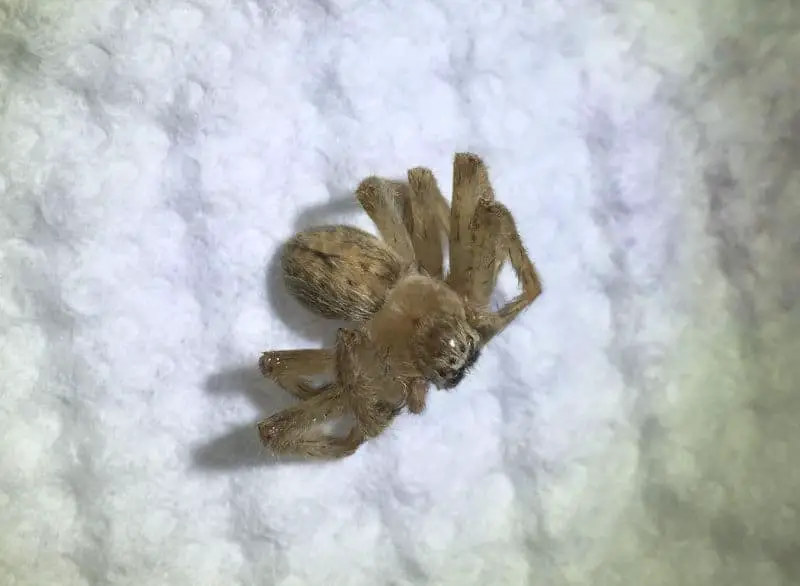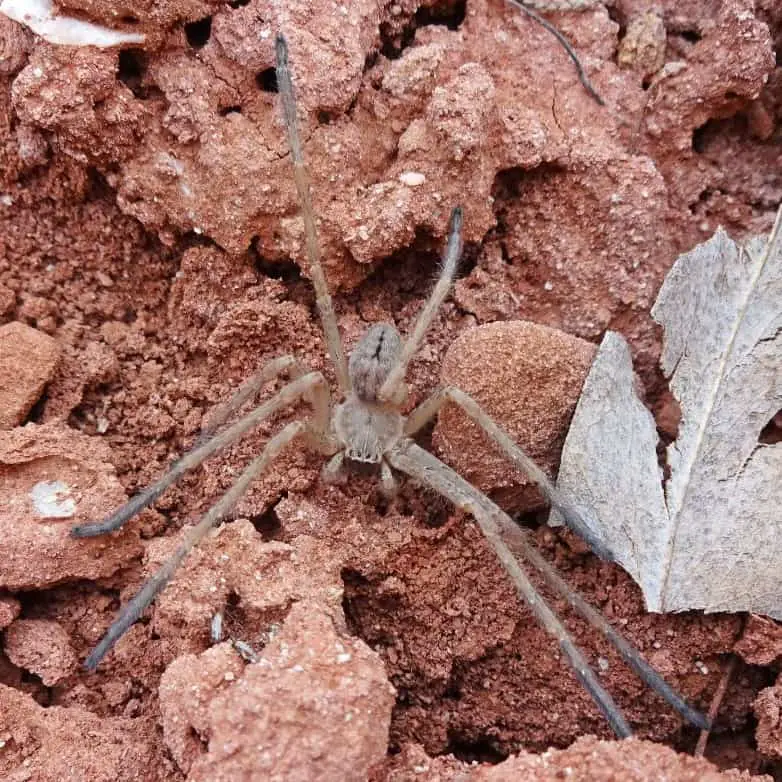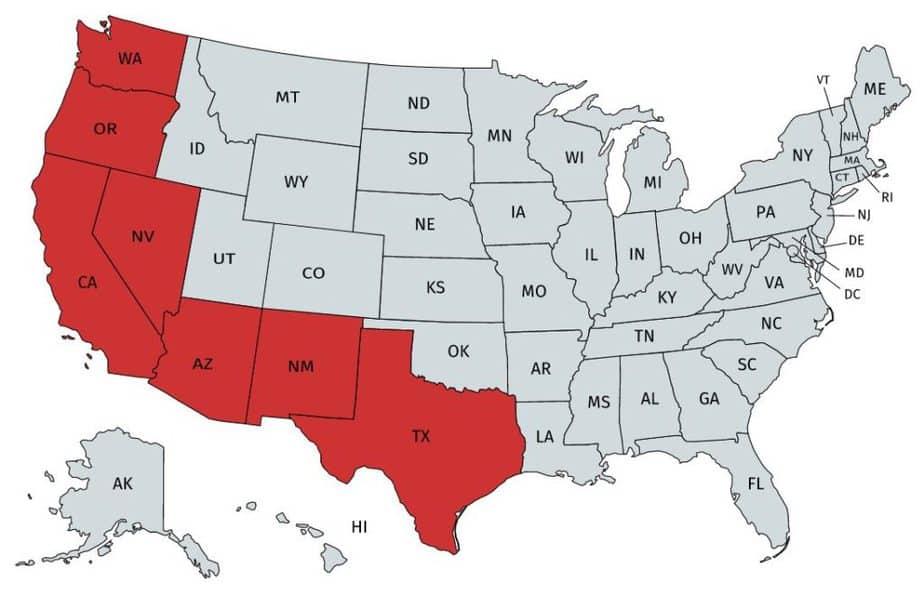Olios Giganteus, the giant crab spider, belongs to the family of Sparassidae spiders, which are commonly called huntsman spiders. As other crab spiders, they have curved legs which gives them a crab-like appearance. However, the giant crab spider can reach a leg span of up to 6 inches (15 cm) – making them much larger than the normally small crab spiders. The giant crab spider like a warm and dry climate and can be found in the Western and Southern United States.
Giant Crab Spider Description
The body and the legs of the giant crab spider is covered with small hairs. It is mostly a light brown while the color gets darker towards the end of the legs. The spider has a black marking on its back that looks somewhat like a stretched letter “Y”.

Giant crab spiders are very fast runners, climbers, and they can also jump to reach any target.
Size
As mentioned above, the giant crab spider is one of the largest spiders found in the United States. Their bodies can reach a length of up to 0.8 inches (2 cm) and their total leg span can reach up to 6 inches (15 cm).

Web
Huntsman spiders are, as their name suggests, hunters. They do not spin webs to catch their prey. They only use their abilities to wrap their eggs in egg sacs.
Bite
The giant crab spiders can be classified as a rather aggressive species. Especially female specimen with an egg sac react very protective for their offspring and often attack any potential threat. This can also be humans.
Due to the speed and the abilities to climb over any obstacle, it can be hard to shake off a giant crab spider once it walks on a human being. The spider may consider these attempts as hostile and go into attack mode.
The bite of a giant crab spider can be quite painful – more painful than most other spider bites and mostly more severe than a bee sting. The venom of the spider often causes some nausea, headaches and local swellings.
However, these symptoms usually wear off with a couple of hours and hospital treatment is usually not required.
Olios giganteus scientific classification
- Kingdom: Animalia
- Phylum: Arthropoda
- Subphylum: Chelicerata
- Class: Arachnida
- Order: Araneae
- Infraorder: Araneomorphae
- Family: Sparassidae
- Genus: Olios
- Species: Olios giganteus
Giant Crab Spider Range in the US

The giant crab spider can be found in the western and southern states of the US. Namely, these are: Washington, Oregon, California, Nevada, Arizona, New Mexico and Texas.


Found this on our window by the AC unit ona hot day in Riverside County, Southern California, August, 2021
Is this a crab spider? Male or female? It is living in my covered outdoor swing on my patio. The markings lead me to think it is a giant crab spider and it is very fast. I do not plan to kill it unless it is dangerous. We are elderly and I have several health issues, mainly diabetes.
Hello Lynn, thanks for getting in touch! You are right, this is a type of giant crab spider. Assuming you are located somewhere in the Southern U.S., this is most likely a pantropical huntsman (Heteropoda venatoria): https://usaspiders.com/heteropoda-venatoria-pantropical-huntsman/
It’s not medically significant. Due to their size and speed, it’s very unlikely to get bitten as they will run away before humans can approach them.
I found this in our back yard near Phoenix, AZ. Looks like a giant crab spider to me, but the body was more greenish than brown, like most photos seem to show.
Found this spider under my camper when I was packing to leave. Southern part of New Mexico at Leaseburg State park NM. I was in a hurry to leave and used my phone with max zoom for the picture. My guess would be the body was about an inch
Hello Brad, thanks for getting in touch! This is some type of giant crab spider, most likely Olios giganteus: https://usaspiders.com/olios-giganteus-giant-crab-spider/
It’s not a medically significant spider.
I found this one coming out of an outdoor shower in Three Points, AZ (SW of Tucson). She caught my attention, that’s for sure!
Beautiful picture! Thanks for sharing
Spider found in Mesa, AZ. It was uniformly tan or light brown. Leg tip to leg tip about 2 inches. Not extremely active told it was soft and fuzzy feeling.
Is it dangerous to people and pets.
Hello Jim, thanks for getting in touch! This is a giant crab spider, Olios giganteus: https://usaspiders.com/olios-giganteus-giant-crab-spider/
It’s not a medically significant spider and generally harmless for pets or humans.
I found this spider under the cushions n my patio furniture in Tucson AZ. It was around 2 inches in size with body and legs.
Hi Wendy, thanks for sharing this great find! This is a giant crab spider (Olios giganteus): https://usaspiders.com/olios-giganteus-giant-crab-spider/
This dude tried to drop on my head while I was taking the trash out lol. I caught him and released a little further away from my house
Super was in Mesa Az . Light tan in color about 2 inches leg to leg, fuzzy feeling. Not very active or fearful. Scooped up with sheet of paper and relocated to grass garden area. Did not see evidence of web on patio table near pool mid march.
Hi Jim, this is a giant crab spider (Olios giganteus): https://usaspiders.com/olios-giganteus-giant-crab-spider/
This is my pest control and bathroom buddy. I’m in and out all night so I get bugs in the house. His name is Steve. I wet down the shower. He spends just enough silk that he can get up and down the shower ball and not slip. I’ll leave the light on at night so the bugs will go in there instead of the bedroom. In the morning, when I need to shower, he heads for the vanity ceiling. I will send a picture of the beginning of his day and where he sleeps.
Hi Julie, thanks for taking such great care of Steve – I am sure he appreciates it. Steve is a giant crab spider (Olios giganteus): https://usaspiders.com/olios-giganteus-giant-crab-spider/
Would you mind sharing in what state you and Steve are located?
This picture gives you a better idea of Steve’s size. It is 1 inch molding.
Found in Central California.
Hello Billy, this is a giant crab spider (Olios giganteus): https://usaspiders.com/olios-giganteus-giant-crab-spider/
Patrolling on my back door, in Alpine TX at 5,270 feet.
This was under a pillow on the outdoor couch I sat on in Carefree AZ. Now I’m scared to sit on my patio. 😵💫😝
I came outside to do the last check on the cats and go to bed. Found this guy waiting just outside the door. Not a fan of spiders and he is quite big! We live in Bandera, TX. His color is very light almost grey. I’m thinking a huntsman spider but is it a giant crab spider?
Was trimming my Kalanchoe plant and was ready to grab next stem when I went…ooohhhhh. He or she matches some of the dried leaves perfectly. Thanks to your article feel confident it is a Giant Crab Spider. Spring day in Tucson AZ
Found one hiding today while I was setting up the automatic sprinkler system for my mini garden. I am not a spider fan, but I wasn’t about to move it and it stayed crouched there as I worked, definitely watching me. I hope it enjoys the water it’ll have available, and the garden is a wonderful place for it to kill the bugs there. I’ll just remember to check before I grab things go… and I’m glad I didn’t look it up until I was done… the description here isn’t helpful to calm the anxiety.
Found this one on outside garage door in Lake Isabella CA. First one I ever seen. Approx 6 inches in circumference. Large as most turantulas I have seen.